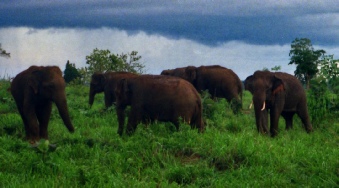© 2023 Dr Margaret Sheppard
Wild Elephants
Sri Lankan elephants are smaller than African elephants. Formerly tamed elephants worked in the Jungles and on ceremonial and religious occasions. There are still many wild elephants but with an increasing population, the traditional elephant areas are diminishing. They have also developed a taste for paddy fields and sugar cane and in order to reach these delicacies, they trample through properties and houses. The Wildlife and Forestry Departments have tried to create Jungle Corridors for them to move from one territory to another, and along some main roads electrified fences have been erected to protect them from traffic. However annually, sadly there are several elephant deaths often creating orphans. There are various elephant orphanages and as many of these as possible are eventually returned to the wild. Those who cannot be rehabilitated often become dearly beloved Temple Elephants lovingly cared for by a keeper, and are seen in the spectacular Perahera parades.



Fortunately, very few Sri Lankan elephants have tusks -
Udawalawa National Park












Wild herd along road East to Trincomalee
Electrified “elephant” fences placed by Wildlife Department to safeguard elephants from roads.
Yala East National Park






Wild elephants along the main Kataragama -
During the Civil War a margin of this road was cleared of Jungle. Every morning this wild elephant waited patiently by the log for a soldier. First Pujah (white flowers on his forehead) then he is rewarded with a pumpkin bought at roadside stall by passer-






This wild elephant makes daily trips from his Jungle home to visit the Head Monk at the nearby Jungle Temple. Coming out of the Jungle, he progresses up the footpath from the Pilgrim’s car park and rest house
On the way uphill, he stops to take a bath at the Tank (reservoir)



On arrival at the Monks’ quarters, he stops for a drink at their water tank, then continues to he Head Monk’s house






He knows that the Head Monk is awaiting him with a bag of buns!
After his daily treat, he respectfully backs away and then returns to the Jungle
Sadly there are elephant orphans There are various Elephant Orphanages. This one is near Udawalawa National Park. The staff care for the orphans. Some are very young. Tourists are allowed to watch the baby elephants being fed. They are advised on the leaflets issued with their entrance tickets about what powdered milk to purchase at the nearby small shops which is then handed to the keepers, mixed appropriately, and then fed to the baby elephants who are carefully herded in from the surrounding paddocks.
As the orphans develop most are returned to the wild in the nearby National Park. If this is not possible and they need continual human care,they are relocated to Temples and eventually become Temple elephants.
Feeding time. The orphans are herded gently in from the paddocks in small groups . The spectators are only permitted to observe the feeding times from a distance. This is to reduce unnecessary human contact as the aim is to return the orphans to the wild. The keepers ensure that the smallest babies receive their milk and are not pushed out of the way by the larger ones.
You Tube Video Links:
Elephant Washing & Dressing Himself -
https://youtu.be/3diyq29cKpM
Elephant Praying at Temple Shrines
https://youtu.be/wp1Z-
Costumed Hanuman Monkey Dancers & Elephants at Kataragama Maha Perahera Temple Procession
https://youtu.be/CsMTVKm7hIY